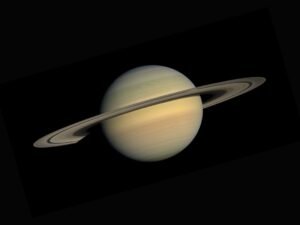Eris is a dwarf planet located in the Kuiper Belt, a region of the outer solar system that is home to a vast number of icy bodies and small objects. It is the largest known dwarf planet and the ninth most massive body orbiting the Sun. Eris was first discovered in 2005 and has since been the subject of much scientific interest and debate. Its discovery has also had significant implications for our understanding of the solar system and the classification of celestial bodies.
Eris is a fascinating and enigmatic world that has captured the imagination of astronomers and space enthusiasts alike. Its remote location and unique characteristics make it a compelling object of study, and its discovery has raised important questions about the nature of our solar system and the objects that inhabit it. In this article, we will explore the history of Eris’s discovery, its physical characteristics and composition, its orbit and relationship with Pluto, its moons and other satellites, its role in the Kuiper Belt and the solar system, and the future missions and research that are planned to further our understanding of this distant and mysterious world.
Key Takeaways
- Eris is a dwarf planet located beyond Pluto in the Kuiper Belt.
- It was discovered in 2005 and named after the Greek goddess of strife and discord.
- Eris is about the same size as Pluto and is composed of rock and ice.
- Its highly elliptical orbit takes it as far as 97 AU from the sun, and it is currently the most distant known object in the solar system.
- Eris has one known moon, Dysnomia, and its discovery has led to reclassification of the solar system’s objects.
Eris’s Discovery and Naming
Eris was first observed on January 5, 2005, by a team of astronomers led by Mike Brown at the Palomar Observatory in California. The discovery was initially announced to the public on July 29, 2005, and Eris was given the provisional designation 2003 UB313. However, it was not until September 13, 2006, that the International Astronomical Union (IAU) officially classified Eris as a dwarf planet, making it the first object to be identified as such other than Pluto.
The naming of Eris has its own interesting history. Initially, it was informally referred to as “Xena” after the television character played by Lucy Lawless. However, in 2006, the IAU officially named the object Eris, after the Greek goddess of strife and discord. This name was chosen due to the controversy surrounding Eris’s discovery and its subsequent impact on the classification of celestial bodies in the solar system. The dwarf planet’s moon, Dysnomia, was named after Eris’s daughter, who personified lawlessness.
Eris’s Physical Characteristics and Composition
Eris has a diameter of about 2,326 kilometers (1,445 miles), making it slightly larger than Pluto. Its surface is covered in frozen methane, nitrogen, and water ice, giving it a highly reflective appearance. Eris’s density suggests that it is composed primarily of rock and ice, with a small amount of metal. Its surface temperature is estimated to be around -231 degrees Celsius (-384 degrees Fahrenheit), making it one of the coldest objects in the solar system.
Eris’s surface is also marked by a dark spot near its equator, which is thought to be a region of exposed rock or a possible impact crater. This feature sets Eris apart from other objects in the Kuiper Belt and has led to speculation about its geological history and formation. The dwarf planet’s surface is also thought to be relatively young, with evidence of recent geological activity such as cryovolcanism and tectonic processes.
Eris’s Orbit and Relationship with Pluto
| Aspect | Eris | Pluto |
|---|---|---|
| Discovery | 2005 | 1930 |
| Orbital Period | 558 years | 248 years |
| Distance from Sun | 96 AU | 39 AU |
| Relationship | Dwarf planet | Dwarf planet |
Eris orbits the Sun at an average distance of about 10 billion kilometers (6.2 billion miles), taking approximately 557 Earth years to complete one orbit. Its highly elliptical orbit takes it from a distance of about 5.7 billion kilometers (3.5 billion miles) at its closest approach to the Sun to about 14.7 billion kilometers (9.1 billion miles) at its farthest point. This makes Eris’s orbit significantly more elongated than that of Pluto.
Eris’s orbit also has a high inclination relative to the plane of the solar system, which means that it is tilted at an angle of about 44 degrees. This makes it one of the most inclined orbits of any known dwarf planet or large object in the Kuiper Belt. Eris’s orbit is also highly eccentric, which means that it is more elongated than most other objects in the solar system.
Eris’s Moons and Other Satellites
Eris has one known moon, Dysnomia, which was discovered in 2005 by Mike Brown and his team at the Palomar Observatory. Dysnomia is much smaller than Eris, with a diameter of about 700 kilometers (435 miles), and orbits its parent body at a distance of about 37,370 kilometers (23,200 miles). The moon is named after Eris’s daughter in Greek mythology and is thought to have been formed from debris ejected during a collision with another object.
Dysnomia’s orbit around Eris is relatively stable, but it is still subject to gravitational perturbations from other objects in the Kuiper Belt. This makes it an interesting target for further study and observation, as it may provide valuable insights into the formation and evolution of Eris and other objects in its vicinity. There may also be other smaller satellites or debris in orbit around Eris that have yet to be discovered.
Eris’s Role in the Kuiper Belt and Solar System

Eris’s discovery has had significant implications for our understanding of the Kuiper Belt and the broader solar system. Its size and composition have challenged traditional definitions of what constitutes a planet, leading to a reevaluation of how celestial bodies are classified and categorized. The debate over whether Eris should be considered a planet or a dwarf planet ultimately led to the reclassification of Pluto as a dwarf planet as well.
Eris’s unique characteristics have also raised important questions about the formation and evolution of objects in the outer solar system. Its highly reflective surface and dark spot suggest that it may have experienced significant geological activity in its past, which could provide valuable insights into the processes that have shaped other icy bodies in the Kuiper Belt. Studying Eris may also help us better understand the origins of comets and other small objects that populate this region of the solar system.
Future Missions and Research on Eris
While no dedicated missions to Eris have been planned as of yet, there is ongoing interest in studying this distant world through ground-based observations and space telescopes such as the James Webb Space Telescope (JWST) and the upcoming Nancy Grace Roman Space Telescope. These instruments will allow astronomers to gather more detailed information about Eris’s surface composition, geological features, and potential atmosphere.
In addition to telescopic observations, there is also interest in sending spacecraft to explore Eris and other objects in the Kuiper Belt in more detail. While no specific missions have been approved, proposals for future missions to this region of the solar system are being considered by space agencies such as NASA and ESThese missions could provide valuable data on Eris’s composition, surface features, and geological history, shedding light on its role in the Kuiper Belt and its significance for our understanding of the solar system as a whole.
In conclusion, Eris is a fascinating world that has challenged our understanding of the solar system and its diverse inhabitants. Its discovery has sparked important debates about how we classify celestial bodies and has raised intriguing questions about the formation and evolution of objects in the outer solar system. As our technology continues to advance, we can look forward to further exploration and research on Eris that will deepen our understanding of this distant and mysterious world.
Discover more about the mysterious and intriguing Eris planet in our latest article. Learn about its unique characteristics and how it challenges our understanding of the solar system. For more fascinating reads, check out this article on the passing of Gary Graham, known for his roles in “Alien Nation” and “Star Trek: Enterprise.”




















+ There are no comments
Add yours